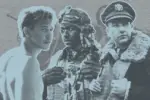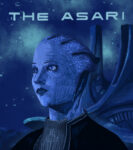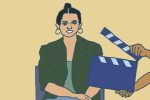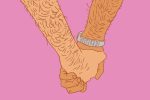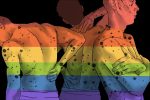When I’m looking for people like me, I hunt down Shane McCutcheon. I find Callie Torres and Arizona Robbins. I search for Waverly Earp and Nicole Haught. All of which is to say, I spend hours sifting through YouTube videos of television’s finest lesbians, from badass butches to female power couples. I never thought about it, the compilation of lesbian characters that autoplay on my YouTube feed one after the other. At least, I didn’t, until I watched “Visible: Out on Television,” a five-episode docuseries directed by Ryan White outlining the history of LGBTQ representation on TV.
Released in February of this year on Apple TV+, “Visible: Out on Television” recounts the evolution of queer representation from the early days of television in the 1940s and 1950s, a time when the Code of Practices for Television Broadcasters prevented positive portrayals of homosexuality on TV, to present day, when numerous shows have featured LGBTQ characters of all kinds.
Via in-depth interviews, “Visible: Out on Television” is told mostly through notable voices of the LGBTQ community. Such voices include actors and activists who lived through the absence of queer representation both on the TV screen and in their day-to-day life, and who talk openly about overcoming hurdles of homophobia to bring representation of their own kind to living rooms across the country.
“Visible: Out on Television” also contextualizes LGBTQ history through the lens of television, and as you may have already guessed, not all of it is sunshine and rainbows.
Ellen DeGeneres, a comedian known for her ’90s sitcom and her daily talk show, describes her harrowing experience coming out as gay in the media, and as a result, being shamed by everyone on late-night television and losing her sitcom. Actor and performer Billy Porter, who currently stars on the show “Pose,” stares wide-eyed at the camera as he recalls people dropping dead in the streets during the AIDS epidemic. Anne Kronenberg, the campaign manager of California’s first openly gay elected official, Harvey Milk, remembers the sea of candles that lit San Francisco during a vigil after Milk’s ruthless murder in 1978.
However, the point of “Visible: Out on Television” isn’t to just list the hardships faced by the gay community as it sought out representation on television — it’s to explain why queer representation on television is so important in the first place.
At its core, “Visible: Out on Television” asserts that people don’t just watch television for a “good” storyline as much as they do for one that reflects their own existence. They gravitate toward characters who look and talk like them and are attentive to plot lines similar to the ones that have unraveled throughout their own lives.
Oprah Winfrey, a television host known for her iconic 25-year talk show, “The Oprah Winfrey Show,” described on-screen representation as a form of validation.
“When you see images that are reflective of your own life, it is a reminder to you that your life matters,” Winfrey said. “That is the one thing that every human being needs validation for.”
While this statement is applicable to any person with a beating heart, it rings beyond true for members of the LGBTQ community, who may not only infrequently see members of their own community in their day-to-day life, but also hardly see representation on magazine covers, in clothing catalogs, car commercials, and yes, on television.
While I can’t say I find myself thinking “I need validation” before I binge-watch badly put together montages showcasing the evolution of TV’s most adored lesbian couples, there is something to be said about needing to feel seen, a natural desire of the human condition to feel like you belong.
In “Visible: Out on Television” Rachel Maddow, a gay television host on MSNBC, likened being portrayed on TV to being seen as a part of the country.
“We are a country that has a lesbian with short hair who is kind of man-ish looking on at 9 p.m. on MSNBC every night,” Maddow said when describing herself.
When I find myself in uncomfortable situations that force me to swallow my pride instead of shouting it, when I sometimes feel like the only gay person in all of Pennsylvania, I look to the people on TV, whether real or made-up, who live the life I know I one day want. The life that is open and unapologetic. The life I might have had no clue of, had it not been for representation on television showing me what it looks like.
In “Visible: Out on Television,” Wilson Cruz, an actor who rose to fame from being cast on the show “My So-Called Life,” emphasized the importance LGBTQ representation has on young people.
“For me the thing that is most moving is to think about a young LGBT person allowing themselves to imagine a future that they are a part of, with no question,” Cruz said.
“Visible: Out on Television” makes it clear that, while queer representation has drastically changed for the better in the past 80 years, work to increase the visibility of the LGBTQ community on screen is just beginning, as more queer writers and directors enter the scene to create content that fully captures their community.
While there have been shows like “Queer as Folk” and “The L Word” that have normalized gay characters, few shows have represented the LGBTQ community in its entirety by including characters who are transgender, bisexual and racial minorities, to name few.
When it comes to LGBTQ representation on television, there are still several barriers that need to be broken and many stories that have yet to be told, but until we get there, I’m thankful to live in a country with a man-ish looking lesbian on MSNBC every night.





